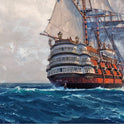Nickel silver on trial

Metal alloys have frequently been used in their naturally occurring form ever since antiquity.
And so it was in the case of nickel silver!
In fact, evidence has been found of the use of an alloy composed of cupronickel and zinc in China since the 4th century. Known as paktong (Cantonese) or baitong (Mandarin), it was notably popular among goldsmiths.
Where coinage is concerned, the use of this type of alloy was a much later development.
In the West, this use logically followed the discovery of the process of isolation of nickel by Axel Fredrick Cronsted in 1751. From then on, it became possible to create precise alloys that were not dependent on ores of uncertain and uneven composition.
At the beginning of the 19th century, it was two French metallurgists from the city of Lyon who developed a new alloy composed of copper, zinc, and nickel. Their names were Maillot and Chor(t)ier, and the French term for the alloy maillechort (formerly also used in English) is a portmanteau immortalizing them forever in their creation: nickel silver was born.
The established formula of nickel silver
Nickel silver should comprise at least 5% nickel, 20% zinc, and 45% copper.
There is also sometimes a little lead added for good measure.
This alloy of copper, nickel, and zinc boasts numerous advantageous qualities such as corrosion resistance and hardness. It is not very oxidizable, and its appearance is undoubtedly reminiscent of silver, while being far less expensive. In addition, it is also non-magnetic.
Brief description of use
Nickel silver is used in a wide range of applications, from tableware to screws, musical instruments, watches, Rolls-Royce grilles, zippers, and even some horse bits.
It also enjoys a certain success in the field that concerns us here: numismatics.


Nickel silver on trial…
As far as coinage is concerned, its usage has experienced a number of phases, and it is obvious that trial coins were part of the first.
In 1856, thirty years after the “creation” of nickel silver, it was the French emperor Napoléon III who got the ball rolling with the first trial on a 5 centime coin.
Münze Frankreich
Essai module de 5 centimes, 1856, ESSAI, S+, Zinc Copper
…First trial in a long series
Numerous other trial coins were then produced in France.
Among the most remarkable, you will surely appreciate the following:
In 1860, this 10 centime trial coin...made of nickel silver, on which we can read opportunely (or not) the inscription on the obverse “Essai des monnaies en nickel” (Trial of nickel coins).
Münze Frankreich
Napoleon III, 10 Centimes, 1860, Paris, ESSAI, UNZ
By 1881, the empire has disappeared, but the republic lives on, as does a very nice trial by Dupré on a 10 centime coin with twelve sides and struck on a burnished blank.
In 1887, it is Merley’s turn, still on a 10 centime trial coin, with a comely Ceres and a simplified reverse.
Münze Frankreich
Merley, 10 Centimes, 1887, Paris, ESSAI, STGL, Maillechort
In 1889, we finally reach the whimsical Theodore Michelin, who took a completely unofficial approach to creation. This gentleman was indeed, in a private way, campaigning for nickel coins, so he could not possibly omit nickel silver from the long list of his various tests.
Münze Frankreich
Théodore Michelin, Centime, 1889, Paris, ESSAI, UNZ+
In fact, he was but a few years away from seeing his dreams become reality.
And to conclude this series of selected trial coins, here we have a very nice “monnaie inaltérable” (unalterable coin) 20 franc trial coin from 1896, the somewhat boastful name of which does not spoil its undeniable presence.
Nickel silver from hand to hand
The coins mainly circulated over the course of the 20th century, and the use of nickel silver was widespread around the world. Among other countries, it was popular in France, Austria, Bulgaria, the Philippines, and Russia.
In the 21st century, it is still in use in Kazakhstan, South Korea, Peru, Serbia, Turkey, and Mexico with its bimetallic 10 peso coin.
Translation: Michael Wright
Iconography:
- "Bethlehem Steel works" by Joseph Pennell (May 1881) (Public Domain)
- "The old china shop" by Ralph Hedley (1877) (Public Domain)
- "L'ancien quartier de la Pêcherie à Lyon" by Jean-Michel Grobon (19th century) (Public Domain)
- Rolls-Royce, The Best Car in the World in The Sketch, 1929 (Public Domain)
- "Portrait of Napoleon III, Emperor of the French" by Charles-Édouard Boutibonne (1856) (Public Domain)
Sources:
- https://en.wiktionary.org/wiki/paktong
- https://www.metal-rolling-services.com/nickel-silver-en
- https://www.merriam-webster.com/dictionary/nickel%20silver
- https://www.etna-mint.fr/index.php?page=maillechort
- https://journals.openedition.org/artefact/1996?lang=en
- https://en.wikipedia.org/wiki/Nickel_silver























